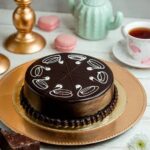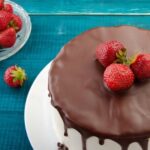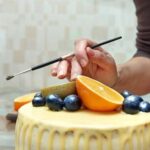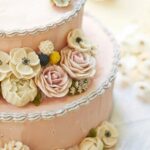Flowers have become increasingly popular in the world of cake decorating, adding a touch of beauty and elegance to any cake design. Their versatility allows for endless possibilities, from simple flower accents to intricate floral arrangements that can truly make a statement. In this blog post, we will provide you with step-by-step guidance on how to make flower cake decorations that will impress your guests and elevate your baking skills.
The use of flowers in cake decorating has gained significant attention in recent years, as more and more people appreciate the visual impact they bring to edible creations. With their vibrant colors, delicate petals, and natural charm, flowers have the ability to transform any ordinary cake into a stunning masterpiece. Whether you’re planning a wedding cake or simply looking to add some flair to a birthday treat, incorporating flowers as decorations is a fantastic choice.
The purpose of this blog post is to equip you with all the knowledge and techniques needed to successfully create beautiful flower cake decorations. From essential tools and ingredients to advanced techniques and troubleshooting tips, we’ve got you covered. So whether you’re a beginner just starting out or an experienced baker looking to expand your repertoire, get ready to unleash your creativity with flower cake decorating.
Essential Tools and Ingredients for Flower Cake Decorating
When it comes to flower cake decorating, having the right tools and ingredients is essential for creating beautiful and professional-looking designs. Whether you are a beginner or a seasoned cake decorator, here are some essential tools and ingredients that you will need:
- Piping Bags: Piping bags are a must-have tool for flower cake decorating. They allow you to control the flow of frosting or icing, making it easier to create intricate flower designs. There are various types available, including disposable plastic bags and reusable fabric bags.
- Flower Nails: Flower nails are used as a base for creating individual flowers. These nails have a flat surface with ridges, which helps hold the flower shape as you pipe the petals onto them.
- Petal Cutters: Petal cutters come in different shapes and sizes, allowing you to create a variety of flower petals. These cutters are typically made of metal or plastic and can be found in specialty baking stores or online.
- Edible Coloring: To bring your flowers to life, you will need edible coloring gels or dusts. These can be mixed with icing or applied directly to fondant or gum paste flowers to add vibrant colors and shading.
- Gum Paste or Fondant: Gum paste and fondant are commonly used to create flower decorations that have a more sculptural appearance. Both materials can be rolled out thinly and shaped into petals, leaves, and other flower parts.
- Flower Stamens: Flower stamens are delicate threads used to mimic the center of flowers. They come in various colors and styles, such as straight or curled, and can be inserted into the center of fondant or gum paste flowers.
While these tools may seem overwhelming at first, there are alternative options available for those on a budget or lacking specific tools. For example, if you don’t have piping bags, you can use a ziplock bag with the corner snipped off as a makeshift piping bag. Additionally, you can create flower petals by hand-cutting them from rolled fondant or gum paste if you don’t have petal cutters.
Having these essential tools and ingredients on hand will set you up for success in your flower cake decorating endeavors. They will help you create stunning floral designs that will impress your friends and family. Remember to practice your techniques and experiment with different colors and shapes to unleash your creativity in cake decorating.
| Tool or Ingredient | Description |
|---|---|
| Piping Bags | Used to control the flow of frosting or icing when creating flower designs. |
| Flower Nails | Act as a base for creating individual flowers. |
| Petal Cutters | Create a variety of flower petals in different sizes and shapes. |
| Edible Coloring | Add vibrant colors and shading to the flowers. |
Choosing the Right Flowers for Cake Decorating
When it comes to cake decorating, choosing the right flowers is crucial. Not only do you want flowers that are visually appealing and complement your cake design, but they also need to be safe for consumption. Here, we will discuss the importance of selecting non-toxic flowers suitable for edible decorations and provide a list of popular edible flowers commonly used in cake decorating.
It is essential to choose flowers that are free from pesticides and safe for consumption. Avoid using flowers from florists or garden centers unless they specifically state that they are intended for culinary use. Many common flowers, such as daisies, pansies, roses, and violets, are suitable for cake decorating and can add a beautiful touch to your creations.
| Flower | Description |
|---|---|
| Roses | Available in various colors and sizes; known for their delightful fragrance. |
| Violets | Purple or blue delicate flowers with a mild flavor. |
| Pansies | A range of vibrant colors; have a slightly sweet flavor. |
Before using any flowers on your cakes, it’s important to properly prepare and clean them. You should never use pesticides or chemicals on any part of the flower that will come into contact with the cake. To clean the flowers, gently wash them under cold water or wipe them with a damp cloth to remove any dirt or debris. Allow them to air dry before placing them on your cake.
Remember, when using fresh flowers on cakes, it’s important to ensure that your guests are not allergic to specific flowers. Always inform them about the presence of edible decorations on the cake and ask if they have any allergies that need to be taken into account. For individuals with severe allergies or dietary restrictions, it may be best to use alternative options such as sugar paste or handcrafted fondant flowers.
By choosing the right flowers for your cake decorating projects, you can create stunning and safe designs that will impress your guests. Whether you opt for classic roses or vibrant pansies, let your creativity bloom as you explore different flower options for your cake decorations.
Getting Started
Decorating a cake with beautiful flowers can elevate its aesthetic and make it truly stand out. Whether you’re a beginner or have some experience in cake decorating, mastering the basic techniques for creating flower decorations is essential. In this section, we will introduce you to the foundational techniques that will help you create stunning flower cake decorations.
Piping Techniques
When it comes to creating flower decorations on cakes, piping is a fundamental skill to learn. Piping involves using a piping bag filled with icing to create various shapes and textures. To get started, you’ll need different piping tips suitable for making petals, leaves, and centers of flowers.
To create flower petals, hold the piping bag at a 45-degree angle over the cake surface and apply pressure while moving your hand in a curved motion. Practice different petal shapes by varying the pressure and angle of the piping tip.
For leaves, use a leaf tip and apply gentle pressure while pulling away from the central vein. Experiment with different lengths and angles to achieve natural-looking leaves.
To create flower centers or stamens, choose a small round tip and pipe small dots or lines in the center of your flower shape.
Step-by-Step Instructions
To further assist beginners, here is a step-by-step guide on how to create a simple buttercream rose:
- Step 1: Prepare your piping bag by attaching a petal tip (such as Wilton #104) at one end.
- Step 2: Fill your piping bag with buttercream icing in your desired color.
- Step 3: Hold the narrow end of the petal tip against the nail (or directly on the cake).
- Step 4: Apply gentle pressure and draw an inclined line from left to right while rotating the nail (or cake).
- Step 5: Repeat step 4 two more times, each time slightly overlapping the previous row of petals.
- Step 6: Add a smaller concentric row of petals inside the larger ones, building up the rose shape.
- Step 7: To create leaves, switch to a leaf tip (such as Wilton #352) and pipe leaves at the base or around the rose.
Remember, practice makes perfect. Don’t be discouraged if your first few attempts aren’t exactly what you envisioned. Keep practicing and experimenting with different techniques until you achieve your desired flower cake decorations.
Visual Examples
For visual learners, it can be helpful to see examples of flower cake decorations in action. Many online resources provide step-by-step tutorials with accompanying images or videos to guide you through each technique. Taking advantage of these resources can help you understand the process better and inspire your creativity when it comes to designing your own flower cake decorations.
Now that you have learned some basic techniques for flower cake decorating, you’re ready to take your skills to the next level. In the next section, we will explore advanced flower cake decorating techniques and designs that will allow you to create intricate and realistic flower decorations for your cakes.
Advanced Flower Cake Decorating Techniques and Designs
Once you have mastered the basic techniques of flower cake decorating, you may be ready to take your skills to the next level. In this section, we will explore some advanced techniques and designs that will truly elevate your flower cake decorations.
1. Creating Delicate Sugar Flowers:
One impressive technique that can truly wow your guests is creating delicate sugar flowers. These lifelike creations are entirely edible and add a touch of elegance to any cake design. To make sugar flowers, you will need gum paste or fondant mixed with Tylose powder for added stability.
Some popular sugar flowers include roses, peonies, and orchids. There are specific tools available for shaping the petals and creating realistic details, such as veiners, foam pads, and ball tools. With practice and patience, you can create stunning sugar flowers that look like they came straight from a garden.
2. Using Edible Wafer Paper:
Another unique technique in flower cake decorating is using edible wafer paper to create intricate designs and accents on your cakes. Edible wafer paper can be shaped into various shapes and sizes to mimic different types of flowers or leaves. It is pliable yet strong enough to hold its shape once dry.
You can color the wafer paper using edible food coloring or dusts to achieve vibrant or realistic hues. From delicate petals to detailed lacy patterns, there’s no limit to the designs you can create with edible wafer paper.
3. Inspiration for Stunning Flower Cake Designs:
To fuel your creativity, here are some inspiring ideas for stunning flower cake designs:
- A cascading floral waterfall: Create a breathtaking design by arranging an assortment of different-sized sugar flowers in a cascading manner down the side of the cake.
- Ombré petal cake: Use different shades of edible food coloring to create an ombré effect on each individual petal of a large flower placed on the cake.
- Floral wreath cake: Arrange a variety of edible flowers in the shape of a ring on top of your cake to create a beautiful and festive floral wreath design.
Remember, it’s important to practice and experiment with these advanced techniques before attempting them on a special occasion cake. By dedicating time to hone your skills, you will be able to create impressive flower cake decorations that will leave everyone in awe.
Troubleshooting Common Issues in Flower Cake Decorating
Common Problems Faced in Flower Cake Decorating
When it comes to flower cake decorating, beginners may encounter various issues that can be frustrating and hinder their progress. It’s important to remember that even experienced decorators face challenges from time to time, and the key is to troubleshoot and find solutions. Here are some common problems faced in flower cake decorating:
- Icing Consistency: One common issue is getting the icing consistency right. If the icing is too stiff, it can be difficult to pipe delicate flower petals or create smooth lines.
On the other hand, if the icing is too thin, it may not hold its shape properly. To address this problem, make sure to follow the recipe for your icing carefully, adding more powdered sugar for a stiffer consistency or small amounts of liquid (such as water or milk) for a thinner consistency. - Piping Mishaps: Another challenge beginners often face is uneven piping or accidental smears. To avoid this problem, practice steady hand movements and maintain consistent pressure on the piping bag while squeezing out the icing. Start with simple designs before moving on to more intricate ones. Additionally, keeping a clean damp cloth nearby will help you quickly remove any errors or excess icing.
- Flower Breakage: Delicate flowers made from sugar paste or fondant can be prone to breaking while handling or during transportation. To prevent breakage, allow your flowers enough time to dry thoroughly before handling them. Use supportive tools like foam pads or drying racks specifically designed for flower decorations when assembling or moving them onto a cake. If necessary, reinforce fragile parts with additional edible glue for added stability.
Solutions and Tips
To overcome these common challenges in flower cake decorating, here are some tips and solutions:
- Practice makes perfect: Like any skill, cake decorating requires practice and patience. Don’t get discouraged by initial mishaps; keep practicing your piping techniques and flower designs to improve over time.
- Invest in quality tools: Using the right tools can make a significant difference in your cake decorating experience. Purchase high-quality piping bags, nozzles, and flower nails to ensure better precision and control.
- Research troubleshooting techniques: There are countless resources available online, such as video tutorials and blog posts, that provide guidance on troubleshooting specific issues. Take advantage of these resources to learn new tips and tricks.
- Seek advice from experienced decorators: Joining online communities or participating in cake decorating classes can connect you with skilled decorators who can offer valuable advice and solutions based on their own experiences.
- Embrace imperfections: Remember that not every decoration needs to be flawless. In fact, imperfections can add charm and a personal touch to your creations. Don’t be afraid to experiment and think outside the box.
By addressing common problems faced in flower cake decorating and providing helpful solutions, beginners can overcome these challenges with confidence while honing their cake decorating skills. With practice and perseverance, anyone can create beautiful floral designs on cakes that will leave a lasting impression on friends and family.
Tips for Transporting and Storing Cakes with Flower Decorations
Transporting and storing cakes with delicate flower decorations requires careful attention to ensure that the beauty and integrity of the design are preserved. Whether you are delivering a cake for an event or simply needing to store it overnight, following these tips will help you transport and store your flower-adorned creations with ease.
Firstly, it is crucial to handle the cake with care during transportation. Ideally, place the cake on a sturdy and flat surface such as a cake board or a baking sheet lined with non-slip mats. This will prevent any shifting or sliding during transit. If possible, secure the cake box or container to prevent it from moving around. For added protection, consider investing in speciality cake carriers that have built-in supports to keep the cake steady.
When transporting cakes with flower decorations, it is important to avoid exposing them to extreme temperatures or direct sunlight. Both heat and cold can cause damage to the flowers and compromise their appearance. Additionally, direct sunlight can cause colors to fade and wilt the flowers prematurely. Consider using insulated bags or coolers if necessary, especially in warm weather conditions.
After successfully transporting your flower-decorated cake, proper storage is key for maintaining its freshness. If your cake needs to be stored for a short period of time (less than 24 hours), place it in a cool room away from direct sunlight and make sure it is covered with a clean cloth or plastic wrap to protect it from dust and air exposure.
For longer periods of storage, especially if refrigeration is required due to perishable fillings or frostings, take extra precautions when handling the flowers. Avoid placing them directly against the sides of the refrigerator as this can cause condensation that may damage the flowers. Instead, loosely cover the entire cake with plastic wrap before refrigerating in order to create a barrier between the flowers and moisture.
Overcoming Challenges
Dealing with allergies and dietary restrictions can pose a challenge when it comes to incorporating flowers into cake decorations. However, there are alternative options that can still allow you to achieve beautiful floral designs without compromising on safety or taste. In this section, we will explore some solutions and recommendations for safe flower cake decorating options.
For individuals with allergies or sensitivities to certain flowers, using edible flowers that are known to be hypoallergenic is a great option. Edible flowers such as pansies, violets, marigolds, and daisies are generally considered safe for most people. It’s important to note that not all flowers are edible and some can even be toxic, so it’s crucial to do thorough research or consult with a professional before using any flowers for cake decorations.
If you’re unable to find safe edible flowers or if you prefer an alternative option, sugar paste or fondant can be used to create handcrafted flower decorations. Sugar paste allows you to mold intricate flower shapes that can be placed on top of the cake or used as accents around the sides.
Fondant can also be rolled out and shaped into various flower designs. These options not only provide a solution for allergy concerns but also allow for more creativity and customization in your cake decorating.
In addition to providing safe alternatives, it’s important to communicate clearly with clients or guests about any potential allergens in your cake decorations. Labeling cakes with allergy information can help individuals make informed choices and avoid any adverse reactions. By understanding your customers’ needs and providing suitable alternatives, you can create beautiful flower cake decorations that everyone can enjoy without worry.
Here are some tips for dealing with allergies and dietary restrictions in flower cake decorating
- Research edible flowers that are safe for consumption
- Create handcrafted fondant or sugar paste flowers
- Clearly label cakes with allergy information
- Consult with professionals for guidance on safe flower options
- Stay updated on current research and best practices for flower cake decorating with allergies in mind.
Dealing with allergies and dietary restrictions shouldn’t limit your creativity when it comes to cake decorating. With the right knowledge and alternatives, you can create stunning flower cake decorations that are both safe and visually appealing. By taking these considerations into account, you can ensure that everyone can enjoy your beautiful creations without any concerns or limitations.
Conclusion
In conclusion, flower cake decorating is a beautiful and versatile way to add a touch of elegance and creativity to your cakes. Throughout this blog post, we have explored the essential tools and ingredients needed, discussed how to choose the right flowers for cake decorating, and provided step-by-step guidance on basic and advanced techniques. We have also addressed common issues and challenges that may arise during the process.
Now, it’s time for you to unleash your creativity and embark on your own flower cake decorating journey. Don’t be afraid to experiment with different piping techniques and designs. By combining various flowers, colors, and textures, you can create stunning masterpieces that will delight both the eyes and taste buds.
Remember, practice makes perfect, so don’t get discouraged if your first attempts are not flawless. With time and dedication, you will improve your skills and achieve impressive results. Allow yourself to enjoy the process of creating edible works of art that will bring joy to others.
Whether you’re a beginner just starting out or an experienced baker looking to expand your repertoire, flower cake decorating offers endless possibilities for expression. So go ahead, gather your tools, select some beautiful flowers, and let your imagination run wild. Let each cake become a canvas where you can showcase both your love for baking and your artistic flair. Happy decorating.
Frequently Asked Questions
How to make decorative flowers for a cake?
Making decorative flowers for a cake can add a beautiful touch to any special occasion. To start, you will need gum paste or fondant, which are pliable and easily shaped materials. Roll out the gum paste or fondant with a rolling pin until it is smooth and thin. Use flower-shaped cookie cutters or templates to create uniform floral shapes.
You can also use special flower molds for more intricate designs. Once the shapes are cut, use edible food coloring to add vibrant colors to the flowers. For added dimension, lightly dust the petals with edible shimmer or pearl dust. Allow the flowers to dry completely before placing them on the cake.
How do you decorate a simple cake with flowers?
When decorating a simple cake with flowers, it’s important to choose flowers that complement the overall theme and design of the cake. Fresh flowers can be an easy and stunning option for adding beauty to your cake. Choose pesticide-free blooms that are safe for consumption, such as roses, pansies, or violets.
Gently wash and pat dry the flowers before using them on the cake. If you prefer using artificial flowers, make sure they are designated as food-safe and free from toxic dyes or chemicals. Carefully arrange the flowers around the top or sides of the cake, paying attention to color balance and spacing between each flower.
How do you make easy edible flowers for cakes?
Making easy edible flowers for cakes is an enjoyable way to enhance your baked creations without much hassle. One option is creating delicate buttercream icing flowers by using a piping bag fitted with a petal-shaped nozzle tip. Start by piping small dots in a circular pattern as a base for your flower shape formation. Then, pipe smaller petals around these dots in layers until you achieve your desired floral look – this technique works well for blossoms like roses or hydrangeas!
If you prefer working with gum paste or fondant, roll out your chosen material thinly and then use different sizes of flower-shaped plunger cutters to create various petals. Assemble the petals, gently pinching their bases together to form the flower shape. Finally, let the flowers dry completely before positioning them on your cake for an easy and edible floral decoration.

Welcome to my blog about home and family. This blog is a place where I will share my thoughts, ideas, and experiences related to these important topics. I am a stay-at-home mom with two young children. I hope you enjoy reading it! and may find some helpful tips and ideas that will make your home and family life even better!





